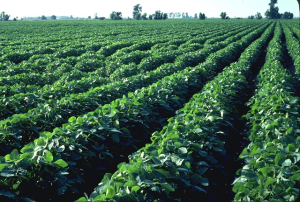Even though it’s nearly August, you still have time to boost soybean yields. Minimizing stress from factors such as insects and disease can  help improve yield results, even as late as the R6 growth stage.
help improve yield results, even as late as the R6 growth stage.
If you regard soybeans as the crop you just need to plant, spray and harvest, think again. With that attitude, you’ll miss out on untapped soybean yield potential, according to Missy Bauer, Farm Journal Associate Field Agronomist. Even though it’s nearly August, she says you still have time to increase yields.
That’s because soybeans, indeterminate varieties especially, are able to respond to management practices and environmental factors that start early, upon emergence, and continue late into the season—even as late as R6. In fact, the bulk of soybean yield is made up during the reproductive growth stages.
Bauer says soybean yields are made up of three components: total number of pods, number of beans per pod and weight per bean (seed size).
"Large yield increases are the result of increased pods per plant," she notes. "The upper limits on beans per pod and seed size are genetically set; together, they can make a sizable difference."
Of the three yield components, Bauer notes that farmers do the best job today of influencing seed size, mainly through the strategic use of fungicides and insecticides when thresholds have been met. Plot data has shown when controlling foliar diseases and/or insects, once thresholds have been exceeded, the resulting improvement in yield can often be attributed to an increase in seed size. Protecting seed size can influence soybean yields as much as 10 bu. to 15 bu. per acre. However, Bauer believes that the upper limit on seed size as well as the potential number of beans per pod are genetically set and won’t budge much beyond what genetics will allow.
Bauer says the majority of yield gains that farmers stand to capture in the future will likely come from increased pods per plant.
The impact of stress. One of the challenges standing in the way of accomplishing increased pods per plant is the problem of flower and pod abortion. Soybeans abort between 60% and 75% of all flowers each season, which are unable to contribute to yield.
"About half the abortion occurs before the flowers develop into young pods, while the other half occurs as a result of pod abortion," Bauer says, adding that there is no specific practice to help farmers reduce pod abortion at this time.
Once soybeans reach flowering (R1), you want to minimize stress, if possible, to prevent yield loss. For instance, stress that occurs from R1through R4 can reduce the number of the pods each plant produces. Stress at R3 through R4 can reduce the size of the pods. Stress at R4 through R6 will cause the beans to abort within the pod, while late stress at R5.5 to R6.5 can reduce the size of the seed itself.
Along with knowing the vegetative and reproduction stages and how they impact growth and development, Bauer says growers need to understand how a soybean works inside the canopy.
Photosynthesis in soybeans is influenced by carbon dioxide (CO2) entering the plant through openings called stomata. When stomata openings close the photosynthesis rate goes down. Heat and moisture stress can cause the stomata to close.
"This can happen to the degree that the plant will run backwards; it burns up its energy inside," she says. "This happens to beans if we have a hot environment and the beans don’t have a chance to cool in the evenings before the sun goes down."
Article By: Rhonda Brooks, Farm Journal Seeds & Production Editor
Read Complete Article Here.

